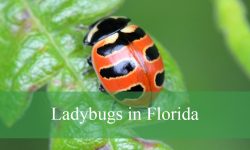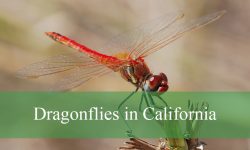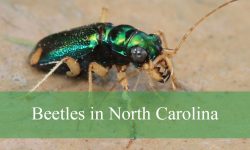Oregon’s vast natural beauty, from its misty coastal forests to its dry high deserts, provides the perfect environment for countless insect species. While most bugs play important ecological roles, a few can be harmful to humans through painful stings, venomous bites, or by spreading diseases. Understanding which species pose a risk is key to preventing unwanted encounters and staying safe outdoors.
This article explores 21 of the most dangerous bugs found throughout Oregon. Each section includes details about their appearance, behavior, preferred habitats, and the specific dangers they present to people and pets. Some may be common in backyards, while others prefer forests, wetlands, or mountain regions.
By learning how to identify these potentially harmful insects, you can better protect yourself while enjoying Oregon’s diverse landscapes. Awareness and caution go a long way toward avoiding painful bites, allergic reactions, or insect-borne illnesses.
Types of Dangerous Bugs Found in Oregon
Black Widow Spider (Latrodectus hesperus)
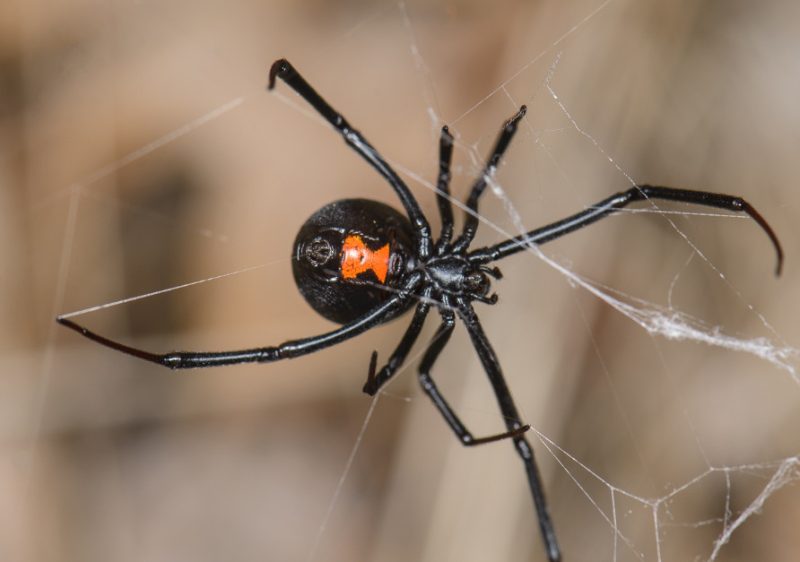
The Black Widow Spider is one of Oregon’s most recognizable and feared arachnids. Females are shiny black with a distinctive red or orange hourglass marking on the underside of their abdomen. Males are smaller and lighter in color, often with faint markings. These spiders measure about 1.5 inches across when legs are extended.
They prefer secluded, dark, and undisturbed areas such as garages, woodpiles, and sheds. Their irregular, messy webs are typically found near the ground. Black widows are not aggressive and will bite only when threatened or trapped against the skin.
The bite of a black widow delivers neurotoxic venom that affects the nervous system. Symptoms may include intense pain, muscle cramps, nausea, sweating, and in rare cases, difficulty breathing. Children, the elderly, and those with weak immune systems are most at risk of severe reactions.
Medical attention is recommended for any suspected bite, as antivenom may be needed in serious cases. While fatalities are extremely rare, black widow venom can cause extreme discomfort and lingering muscle soreness for several days.
Hobo Spider (Eratigena agrestis)
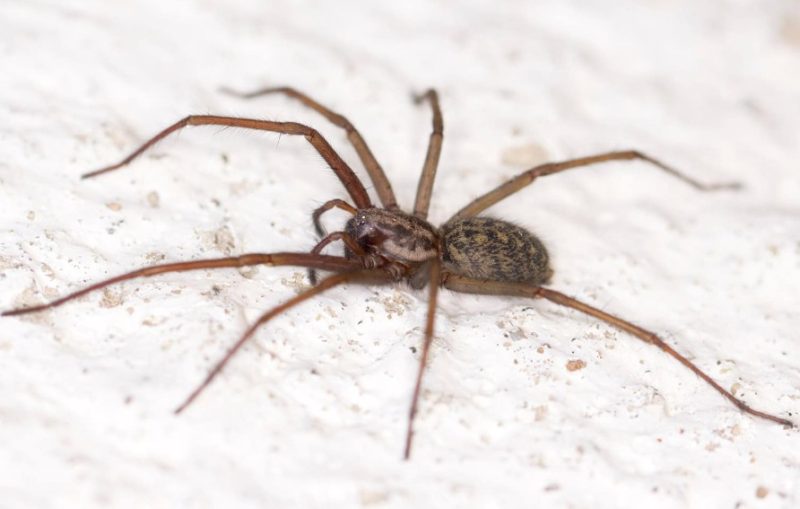
The Hobo Spider is a medium-sized brown spider with long legs and chevron patterns on its abdomen. It lacks the glossy sheen of the black widow and has a more muted, fuzzy appearance. Adults range from ½ to ¾ inch in body length, with long, sturdy legs.
Hobo spiders are ground dwellers that build funnel-shaped webs in dark, quiet places such as basements, crawl spaces, and under rocks or logs. They are fast runners but not skilled climbers, often remaining near ground level. Males are more commonly seen indoors during late summer when searching for mates.
Bites from hobo spiders can cause mild to moderate irritation, redness, and swelling. While earlier studies suggested necrotic effects similar to brown recluse bites, recent research indicates most reactions are minor and non-life-threatening. Pain and itching may persist for several days.
Though not particularly aggressive, they will defend themselves if cornered. Keeping homes clean, sealing cracks, and reducing clutter helps prevent infestations and accidental encounters.
Yellowjacket Wasp (Vespula vulgaris)
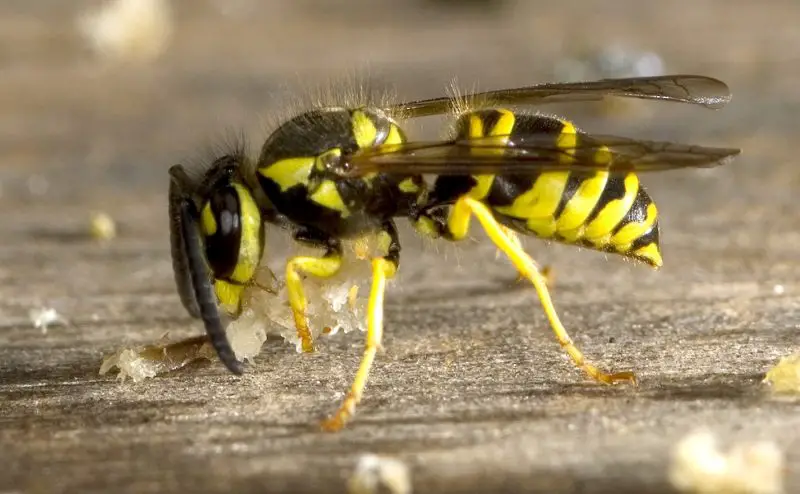
The Yellowjacket Wasp is one of the most aggressive stinging insects in Oregon. It is black and yellow with a sleek, segmented body and transparent wings. Workers measure around ½ inch long, while queens are larger. Their fast flight and loud buzz often make them easy to spot.
Yellowjackets build paper-like nests underground, in wall voids, or inside old tree stumps. They are highly territorial and defend their nests fiercely. Unlike honeybees, yellowjackets can sting multiple times, injecting venom each time. They are especially active during late summer when food sources become scarce.
Their sting causes sharp pain, redness, and swelling, and for allergic individuals, it can trigger dangerous anaphylactic reactions. Multiple stings may also lead to nausea, dizziness, or breathing difficulties. Medical care should be sought if symptoms worsen after a sting.
They are also drawn to sugary drinks, fruit, and picnic foods, which increases the risk of stings during outdoor activities. Proper waste disposal and sealed containers can help reduce yellowjacket encounters.
Bald-Faced Hornet (Dolichovespula maculata)
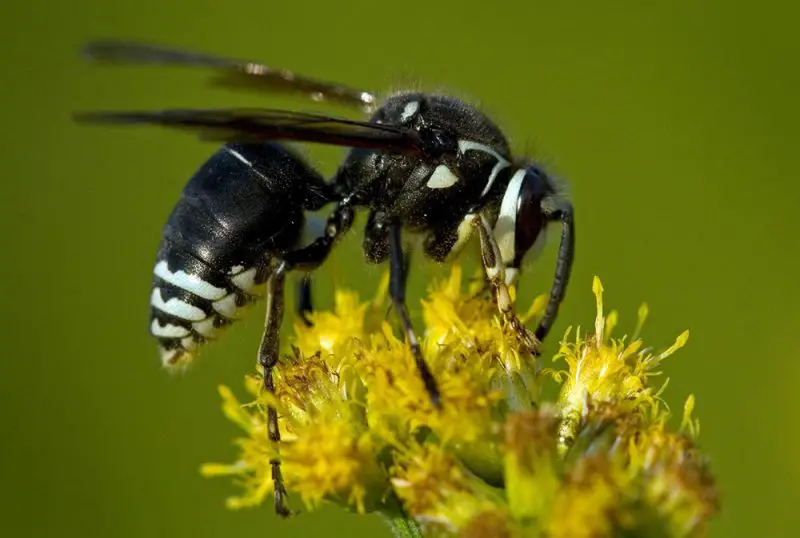
The Bald-Faced Hornet, actually a large black-and-white wasp, is one of Oregon’s most defensive stinging insects. It has a striking appearance with a black body and white facial markings. Workers measure about ¾ inch long, while queens can reach over an inch.
These hornets construct large, gray, paper-like nests that hang from trees, shrubs, or building eaves. Colonies are active during summer and early fall, becoming particularly aggressive when disturbed. They are known to chase intruders for several yards from their nests.
Bald-faced hornets can sting repeatedly, and their venom causes intense pain, burning, and swelling. In some cases, it can lead to systemic allergic reactions requiring emergency treatment. Their defensive nature makes them a concern for homeowners and gardeners alike.
Despite their danger, these hornets also help control pest insect populations, including flies and caterpillars. However, any attempt to remove a nest should be handled by professionals to avoid severe stings.
Western Black-Legged Tick (Ixodes pacificus)
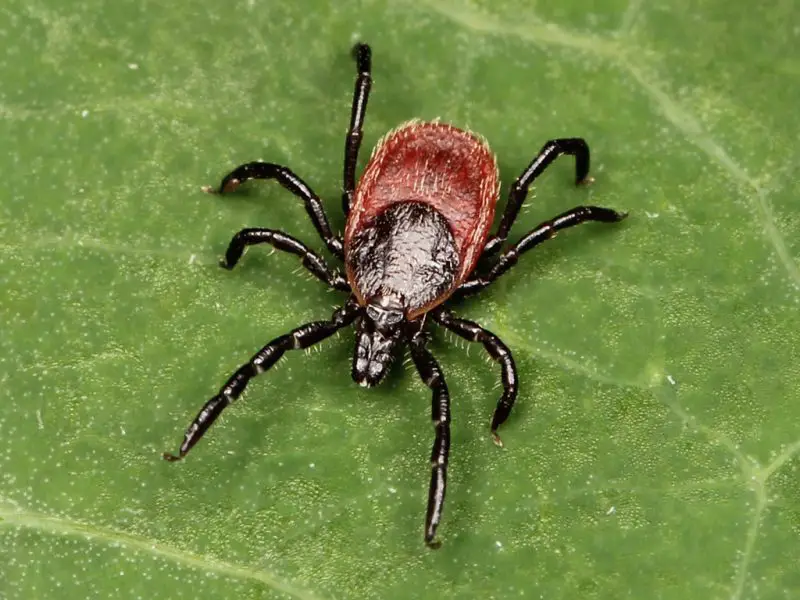
The Western Black-Legged Tick is a small but significant health concern in Oregon. Adults are reddish-brown with black legs, and females have a darker dorsal shield. They measure about 1/8 inch long when unfed but can expand several times their size after feeding.
Ticks thrive in humid, grassy, and wooded environments, particularly along hiking trails and forest edges. They are most active during spring and early summer, waiting on vegetation to attach to passing animals or humans. Nymphs, the immature stage, are the primary carriers of diseases.
This species is the main vector of Lyme disease in Oregon, caused by the bacterium Borrelia burgdorferi. Symptoms can include fever, fatigue, joint pain, and a distinctive bull’s-eye rash. If untreated, the infection can lead to long-term neurological and cardiac issues.
After outdoor activity, thorough tick checks and prompt removal are essential. Using repellents, wearing long sleeves, and avoiding tall grass are the best prevention methods against tick-borne illnesses.
Deer Tick (Ixodes scapularis)
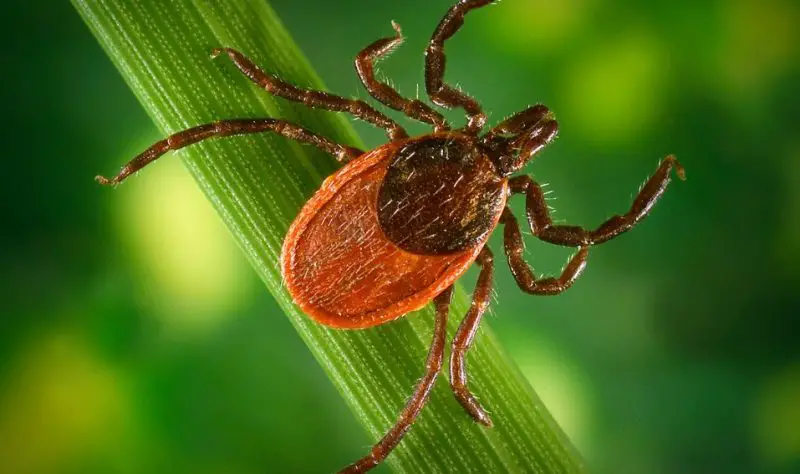
The Deer Tick, also known as the Black-Legged Tick, is a small parasitic arachnid that feeds on the blood of mammals, birds, and reptiles. Adults have dark brown to black legs and reddish-orange bodies, measuring only about 1/8 inch long. Females are larger and easier to spot, especially when engorged after feeding.
In Oregon, deer ticks are found mostly in forested and grassy regions, especially in the western parts of the state. They prefer humid environments with leaf litter, tall grass, or low shrubs. Ticks climb to the tips of vegetation to latch onto passing animals or humans, a behavior known as “questing.”
These ticks are notorious for spreading Lyme disease, caused by Borrelia burgdorferi. They can also transmit other pathogens, such as anaplasmosis and babesiosis, leading to flu-like symptoms, fatigue, and in severe cases, neurological damage. Early detection and treatment with antibiotics are crucial.
To prevent bites, wear long sleeves and tuck pants into socks when hiking, use DEET-based repellents, and perform thorough tick checks after outdoor activities. Prompt removal of attached ticks reduces the risk of disease transmission.
Brown Recluse Spider (Loxosceles reclusa)
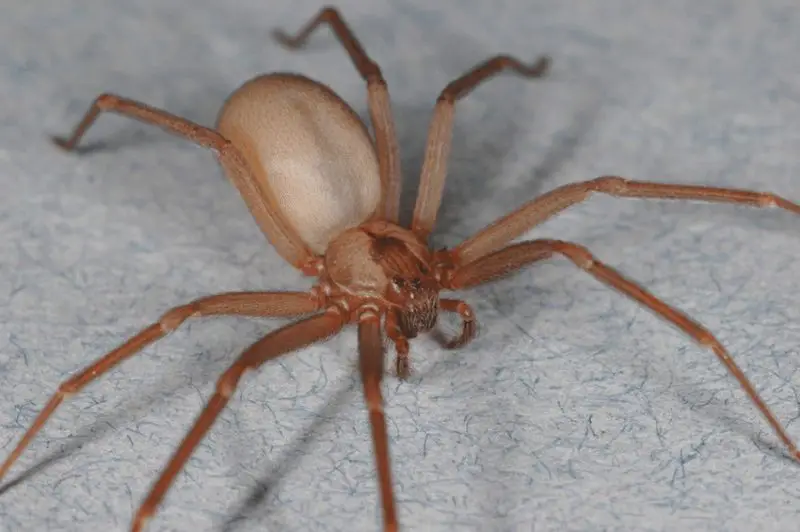
The Brown Recluse Spider is one of the most feared spiders in North America, though it is rare in Oregon and typically introduced via transported goods. It has a light to medium brown color with a distinctive dark, violin-shaped marking on its cephalothorax. Adults measure about 1/2 inch in body length with long, thin legs.
These spiders favor warm, dry, and undisturbed environments such as attics, basements, and behind furniture. They are nocturnal hunters, feeding on small insects and hiding during the day. Their webs are irregular and often found close to the ground.
The bite of a brown recluse injects necrotic venom that destroys tissue at the bite site. Symptoms may include redness, blistering, and ulcer formation that can take weeks to heal. In rare cases, systemic effects such as fever, chills, and organ damage may occur.
Although bites are uncommon, medical treatment is essential if symptoms worsen. Keeping storage areas clean, sealing cracks, and shaking out clothing before wearing can prevent accidental contact with these spiders.
Giant Water Bug (Lethocerus americanus)
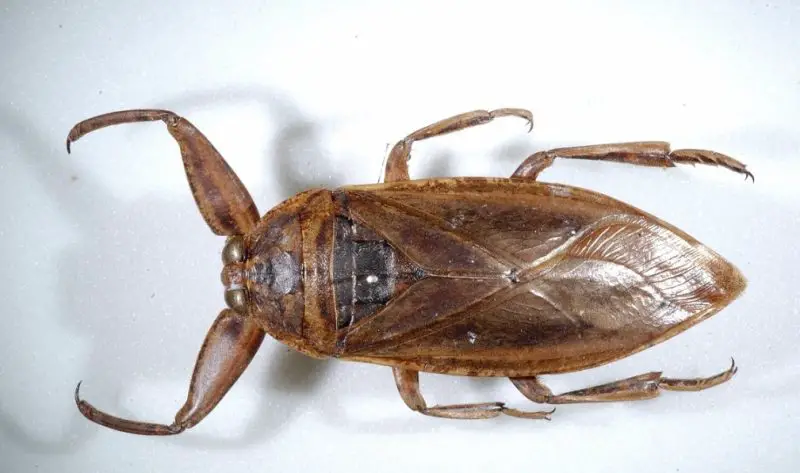
The Giant Water Bug, sometimes called the “toe-biter,” is one of the largest aquatic insects in Oregon, reaching up to 2.5 inches in length. It has a flattened, brownish body, strong forelegs for grasping prey, and a short breathing tube at the rear. Its appearance is often mistaken for that of a beetle.
These bugs inhabit ponds, lakes, and slow-moving streams where they ambush prey such as fish, tadpoles, and other insects. They are excellent swimmers, using their hind legs like paddles. During warm nights, adults are attracted to lights and can sometimes be found on porches or near streetlamps.
Giant Water Bugs can deliver a powerful bite with their piercing mouthparts when handled or stepped on. The bite injects digestive enzymes that cause immediate, burning pain and localized swelling. Fortunately, they are not venomous and pose no long-term medical danger.
Despite their fearsome reputation, they play an important ecological role by controlling aquatic insect populations. Avoiding handling and wearing shoes near water edges helps prevent painful encounters.
Assassin Bug (Reduviidae family)
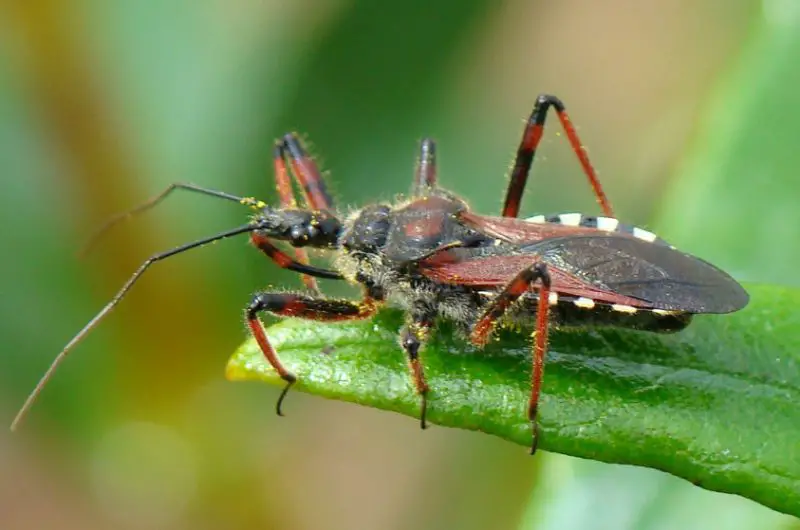
Assassin Bugs are predatory insects known for their elongated bodies, narrow heads, and curved, dagger-like beaks. They range from 1 to 1.5 inches long and come in various shades of brown, black, or red, depending on the species. Their slow movements can be deceptive, as they strike quickly when capturing prey.
These insects are common in Oregon gardens, forests, and fields, where they feed on caterpillars, beetles, and other soft-bodied insects. They are beneficial to agriculture, but a few species can deliver painful bites to humans when handled.
Their bite involves injecting venomous saliva that liquefies the insides of their prey. For humans, this causes immediate burning pain, redness, and swelling that can last for several days. The bite is not usually dangerous but may become infected if not cleaned properly.
Some species, such as the “kissing bug,” can transmit Chagas disease in warmer climates, though this is rare in Oregon. Caution should be taken when identifying these insects, and they should be avoided or relocated carefully if found indoors.
Western Yellowjacket (Vespula pensylvanica)
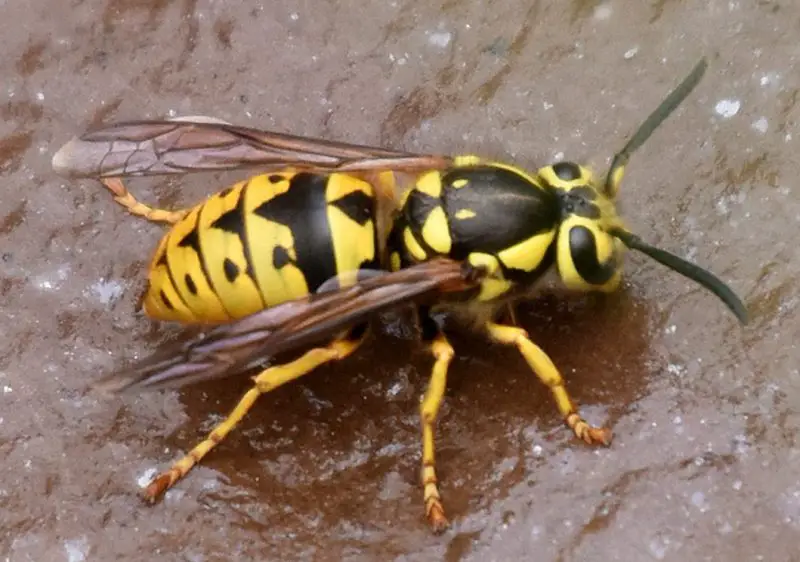
The Western Yellowjacket is among Oregon’s most aggressive stinging insects. It has bright yellow and black banding, a narrow waist, and transparent wings. Workers measure about ½ inch long and are often mistaken for honeybees, though their bodies are shinier and more compact.
This species builds large paper nests in the ground, hollow logs, or wall voids. Colonies can grow to thousands of individuals, becoming especially active during late summer when food sources are scarce. Yellowjackets are attracted to sugary drinks, meats, and garbage, which often brings them into conflict with humans.
Their sting is intensely painful, causing burning, swelling, and itching. Because they can sting multiple times, multiple stings can lead to more severe reactions such as dizziness, nausea, or anaphylaxis in allergic individuals. Immediate medical help is necessary if breathing difficulty or swelling of the throat occurs.
To minimize encounters, keep food sealed, dispose of waste properly, and avoid swatting at yellowjackets. Professional pest control may be required to remove large or hidden nests safely.
Fire Ant (Solenopsis spp.)
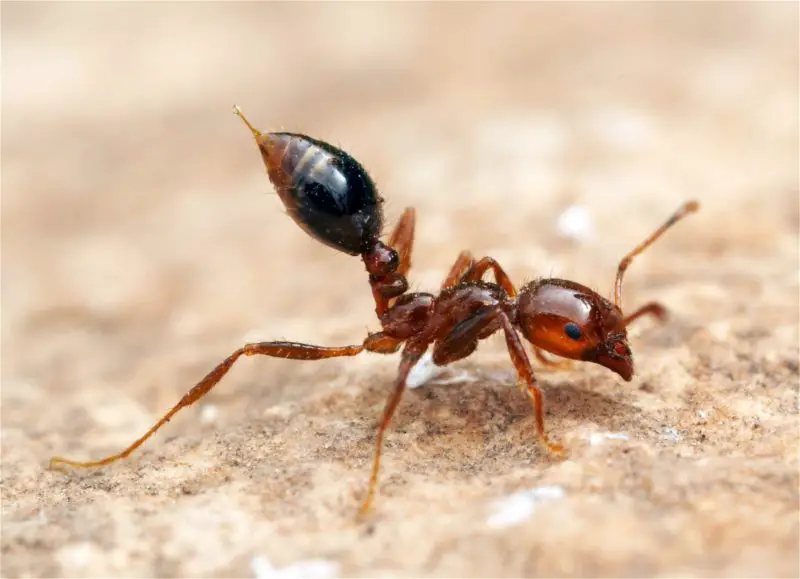
Fire Ants are notorious for their aggressive behavior and painful stings. These small reddish-brown ants measure about 1/8 to 1/4 inch in length and have shiny bodies. Colonies can contain thousands of workers, led by one or more queens. When disturbed, fire ants swarm quickly and sting repeatedly.
They build large, dome-shaped mounds in open, sunny areas such as lawns, fields, and roadsides. In southern Oregon, they are occasionally found in warmer microclimates or transported accidentally through soil and plant materials. Fire ants are highly adaptable and thrive in disturbed habitats.
Their stings deliver venom containing alkaloid toxins that cause intense burning, itching, and the formation of white pustules. Multiple stings can lead to severe pain, and in allergic individuals, systemic reactions such as dizziness, nausea, or anaphylaxis may occur.
Medical attention is recommended for those experiencing severe swelling or allergic symptoms. Avoiding nests, wearing closed footwear, and applying insect repellents can help reduce the risk of stings in infested areas.
Velvet Ant (Dasymutilla occidentalis)
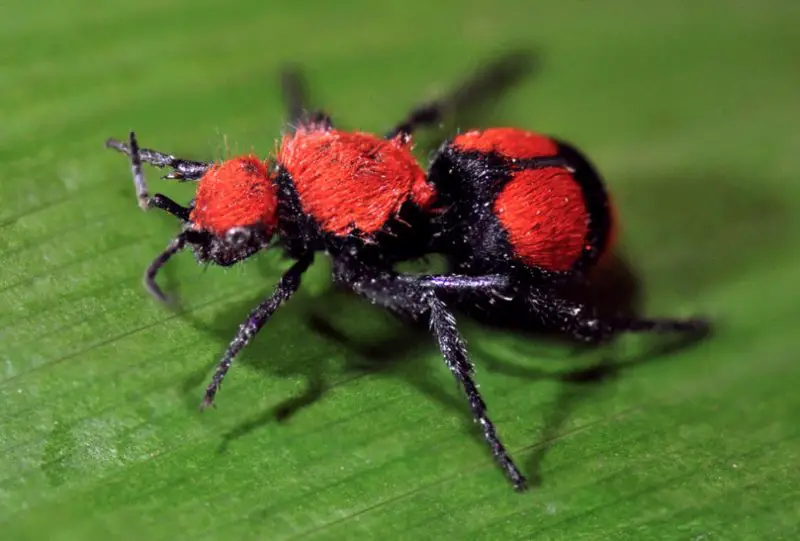
Despite its name, the Velvet Ant is not a true ant but a species of wingless wasp. Females are covered in dense, bright red-orange hair and can reach up to 1 inch long, making them highly visible against sandy or dry ground. Males, in contrast, have wings and are less commonly seen.
These insects are solitary and prefer dry, open environments such as meadows, pastures, and sandy soils. Females wander the ground in search of ground-nesting bees or wasps, where they lay their eggs inside the host’s nest. The larvae then develop by feeding on the host’s pupa.
Velvet ants are famous for their extremely painful sting, often described as one of the most intense in North America. The venom is not deadly but can cause sharp, burning pain that lasts for several minutes. Their tough exoskeleton also makes them difficult for predators to harm.
They are generally non-aggressive and will sting only if handled or trapped. Admiring them from a distance is best, as their sting offers a painful lesson to the curious observer.
Harvester Ant (Pogonomyrmex spp.)
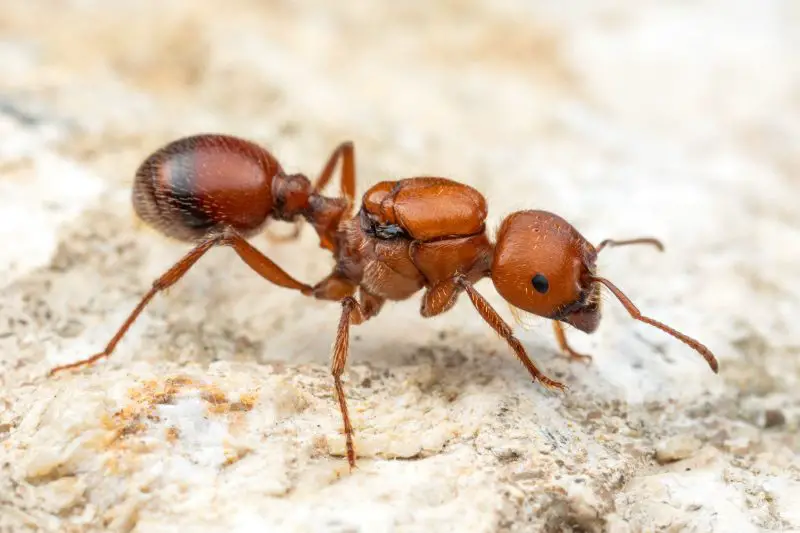
Harvester Ants are medium-sized reddish-brown insects known for their painful stings and organized colonies. Workers range from ¼ to ½ inch long, with large heads and powerful mandibles. They often clear vegetation around their nests, creating noticeable bare circles on the ground.
These ants inhabit open, dry areas such as deserts, grasslands, and arid valleys. In Oregon, they are found primarily in the drier southern and eastern regions. Colonies live underground in elaborate tunnel systems, where they store seeds collected from surrounding plants.
Their stings contain venom that causes immediate burning and swelling, sometimes lasting for hours. In sensitive individuals, multiple stings can trigger allergic reactions or systemic symptoms such as headache or nausea. They rarely bite but sting aggressively when their nests are disturbed.
Despite their painful sting, Harvester Ants play an important ecological role by aerating soil and dispersing seeds. Avoid sitting or standing near their nests, and wear shoes when walking through dry, open terrain to prevent accidental stings.
Blister Beetle (Epicauta spp.)
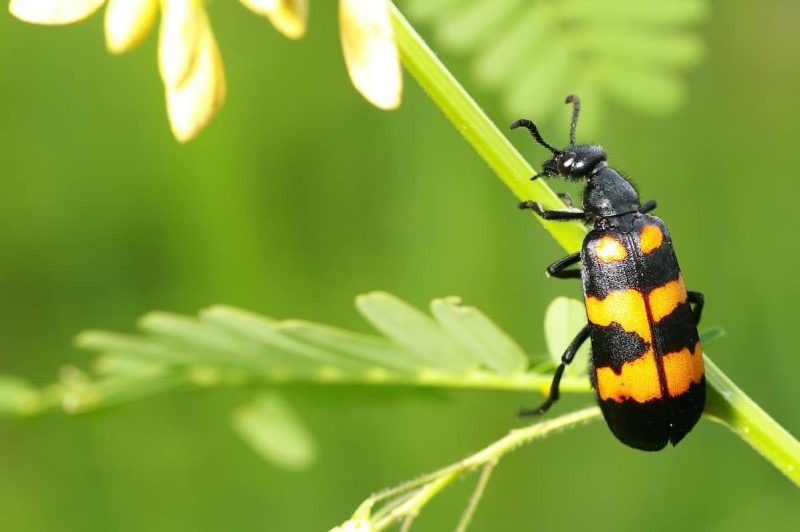
Blister Beetles are slender insects with soft, elongated bodies that range in color from gray and black to metallic green or striped orange. Adults are typically ½ to 1 inch long with flexible wing covers. They are often seen feeding on flowers, alfalfa, and other plants during summer.
These beetles are named for their ability to secrete cantharidin, a toxic chemical that causes blistering when it contacts human skin. Even gentle handling can lead to irritation or painful blisters within hours. The compound also poses a severe threat to livestock, particularly horses, if ingested in contaminated hay.
Blister Beetles inhabit meadows, fields, and gardens throughout Oregon, especially in areas with flowering plants. They are most active during warm weather and may swarm vegetation in large numbers.
While their chemical defense deters predators, it also makes them hazardous to humans and animals. Wearing gloves while gardening and avoiding crushing beetles on skin or plants can help prevent accidental contact with their toxic secretion.
Wheel Bug (Arilus cristatus)
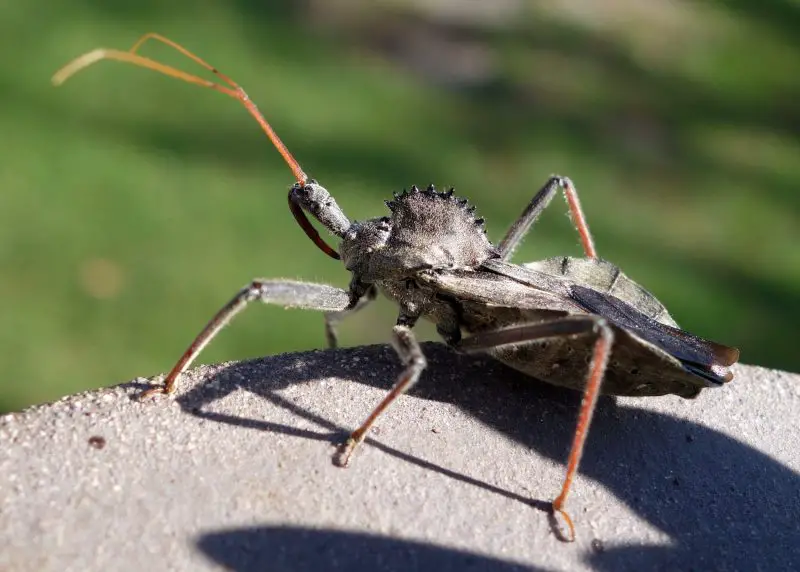
The Wheel Bug is a large predatory insect belonging to the assassin bug family. It grows up to 1.5 inches long and is easily recognized by the cog-shaped, wheel-like crest on its thorax. Its grayish-brown body and long, slender beak give it a menacing appearance.
Wheel Bugs are found in Oregon’s wooded areas, gardens, and agricultural fields, where they prey on caterpillars, beetles, and other pest insects. They are slow-moving but excellent ambushers, injecting venom through their sharp proboscis to immobilize prey.
Though beneficial to gardens, Wheel Bugs can inflict one of the most painful insect bites in Oregon if handled carelessly. The bite results in sharp, burning pain, swelling, and sometimes numbness that can last for several days. In rare cases, the wound may take weeks to heal fully.
Despite their intimidating reputation, these bugs are not aggressive toward humans and only bite in self-defense. Observing them without handling ensures both their safety and yours.
Paper Wasp (Polistes spp.)
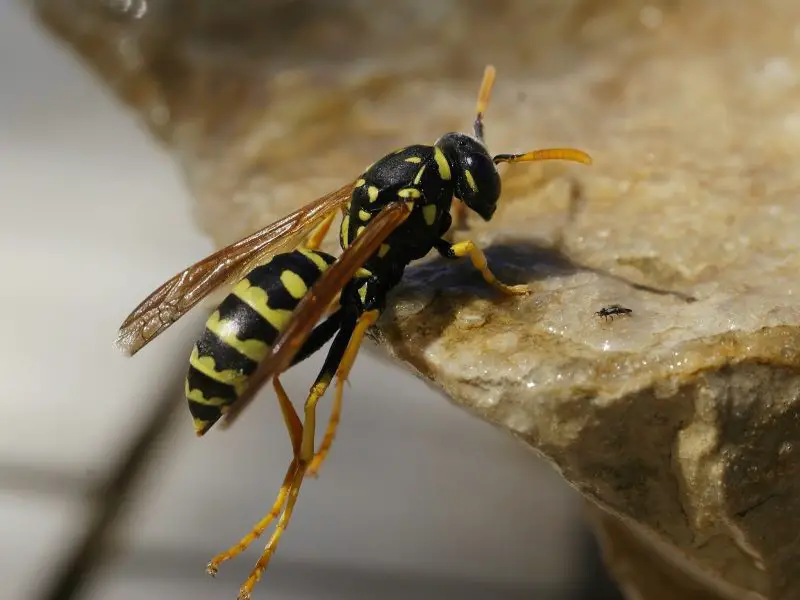
Paper Wasps are slender, long-legged insects with brown or reddish bodies and yellow markings. They typically measure around ¾ inch long and are often mistaken for yellowjackets, though they have thinner waists and longer legs that dangle in flight. Their name comes from the papery nests they construct.
They build umbrella-shaped nests made of chewed wood fibers mixed with saliva, attaching them to eaves, porches, or tree branches. Colonies are small compared to yellowjackets, usually consisting of a few dozen individuals. Paper wasps are social and defend their nests if threatened but are generally less aggressive than other wasp species.
Their sting injects venom that causes sharp pain, swelling, and redness at the site. Although not typically dangerous, multiple stings or allergic reactions can lead to more serious symptoms, including dizziness or breathing difficulty. Unlike bees, paper wasps can sting repeatedly.
Paper wasps also play a beneficial role by controlling caterpillar populations in gardens. However, nests near human activity should be approached with caution or professionally removed to prevent stings.
Kissing Bug (Triatoma protracta)
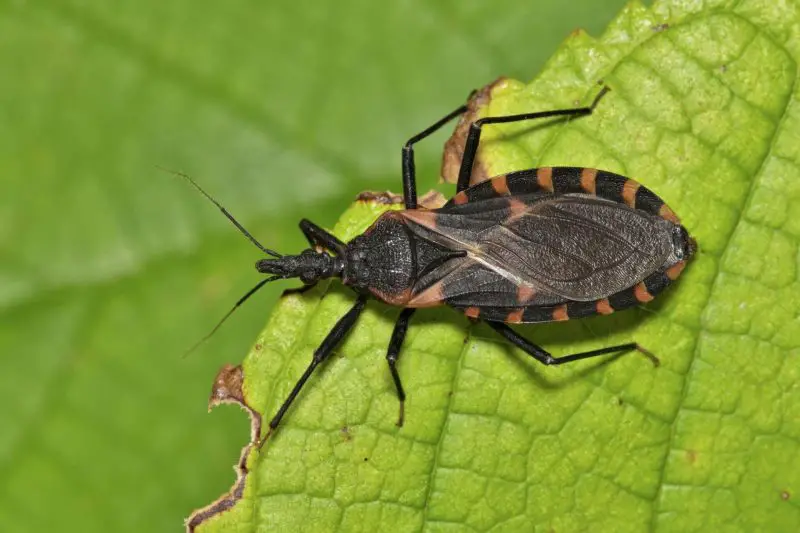
The Kissing Bug, sometimes called the “conenose bug,” is a blood-feeding insect that occasionally appears in southern Oregon. It has a dark brown to black elongated body, a pointed head, and orange or red edges on its abdomen. Adults measure about 1 inch long and are nocturnal.
These bugs are attracted to warm, sheltered environments such as cracks in walls, pet bedding, or woodpiles. They feed at night, usually biting humans or animals near the mouth or eyes, which is how they earned their name. Though rare in Oregon, they are more common in southwestern U.S. states.
Their bite is not inherently dangerous, but some species can transmit Chagas disease, caused by the parasite Trypanosoma cruzi. This disease can lead to long-term heart and digestive complications if untreated. Fortunately, Oregon’s kissing bug population rarely carries the parasite.
Bites may cause swelling, redness, or itching, and some individuals develop allergic reactions. Sealing cracks, using window screens, and keeping outdoor lights minimal can help prevent kissing bugs from entering homes.
Mosquito (Culex and Aedes species)
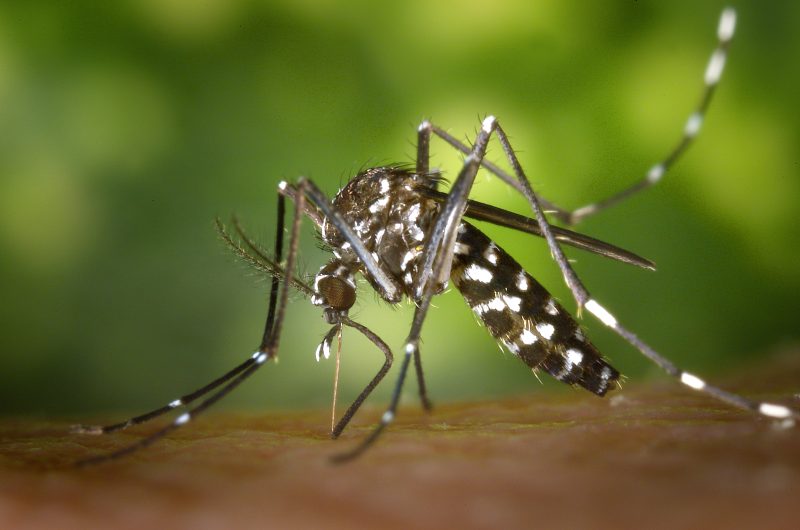
Mosquitoes are among Oregon’s most common and troublesome insects. Small and delicate, they have long legs, slender bodies, and scaled wings. Females, which feed on blood, are responsible for the buzzing sound that often accompanies summer evenings.
They breed in stagnant water sources such as ponds, birdbaths, and gutters. Oregon’s two main mosquito genera, Culex and Aedes, are active during different times—Aedes mosquitoes bite during the day, while Culex species are most active at dusk and night. Warm, humid conditions promote rapid population growth.
Some mosquito species in Oregon can transmit diseases, including West Nile Virus, which causes fever, fatigue, and neurological complications in severe cases. Their bites also result in itching, redness, and mild swelling, which can lead to infection if scratched.
Reducing standing water around homes, using repellents with DEET or picaridin, and wearing long sleeves outdoors are effective ways to minimize exposure to these pests during peak activity seasons.
Biting Midge (Culicoides spp.)
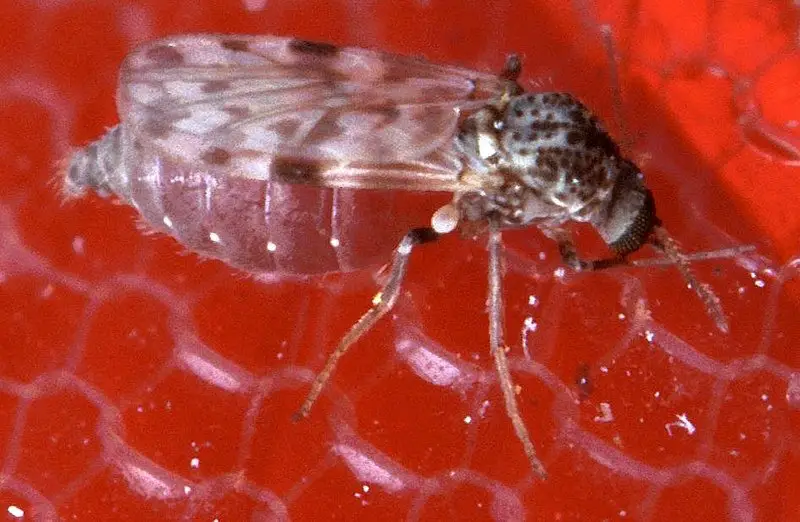
Biting Midges, commonly known as “no-see-ums,” are tiny, nearly invisible flies measuring only 1 to 3 millimeters in length. Despite their small size, they are known for delivering painful bites that cause itching and irritation. Their bodies are grayish with short wings marked by fine patterns.
These insects thrive in moist environments such as wetlands, lakeshores, and marshy areas. In Oregon, they are most active during warm months, especially at dawn and dusk. They often swarm in large numbers and can pass through standard window screens due to their minute size.
Female biting midges feed on blood to produce eggs, using sharp mouthparts to pierce the skin. Their bites result in small, red welts accompanied by intense itching. Some individuals may experience allergic reactions or prolonged swelling from multiple bites.
While they are not known to spread diseases to humans in Oregon, they can transmit viruses to livestock, such as bluetongue in sheep. Insect repellents, fine mesh screens, and fans can help deter them from biting.
Horsefly (Tabanus spp.)
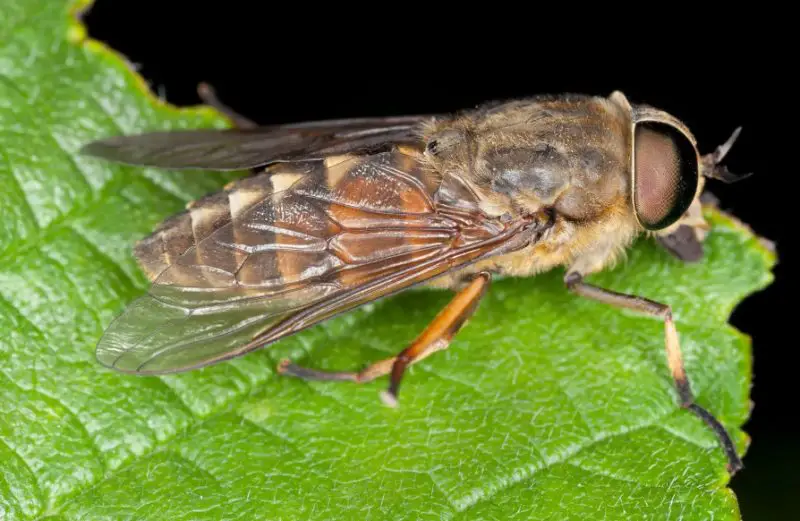
Horseflies are large, fast-flying insects with powerful wings and large compound eyes that shimmer with metallic colors. Females, which bite to obtain blood, can grow over 1 inch long and have sturdy bodies with brown or gray coloration. Males feed only on nectar.
They are typically found near wetlands, rivers, and livestock areas, where they hunt by detecting movement and body heat. Horseflies are most active during summer days and are persistent, often following humans or animals over short distances.
Their bite is painful because they use cutting mouthparts to slice the skin before sucking blood. The result is immediate pain, bleeding, and swelling. Secondary infections can occur if bites are not cleaned properly, and allergic individuals may experience stronger reactions.
Although horseflies do not generally transmit diseases to humans in Oregon, their bites can spread infections among livestock. Wearing light-colored clothing, applying repellents, and avoiding heavily infested areas can help prevent bites.
Flea (Ctenocephalides felis)
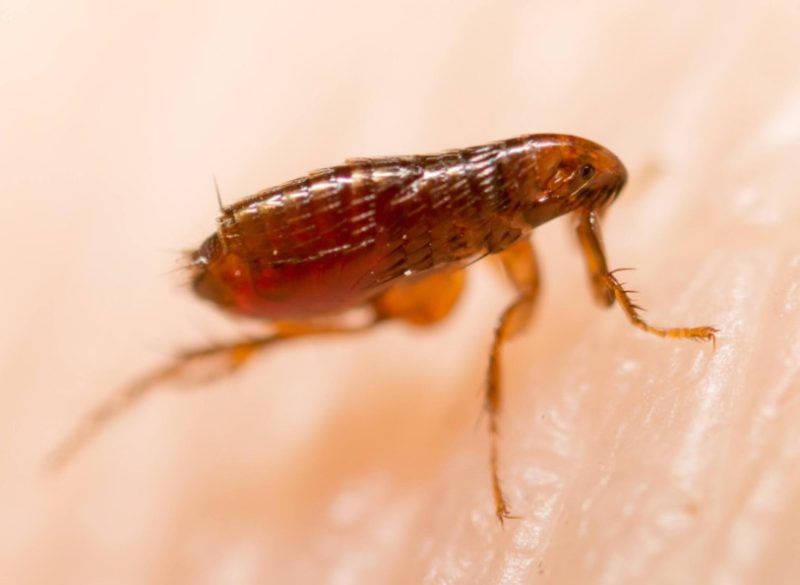
The Cat Flea is the most common flea species in Oregon, affecting both pets and humans. These tiny, wingless insects measure about 1/8 inch long and have laterally flattened bodies that allow them to move easily through fur. Their reddish-brown color and remarkable jumping ability make them easy to identify.
Fleas thrive in warm, humid indoor environments and are often found in carpets, bedding, and pet resting areas. They feed on blood from cats, dogs, wildlife, and sometimes humans. A single female can lay hundreds of eggs, making infestations difficult to control once established.
Their bites cause small, red bumps accompanied by intense itching and irritation. Scratching may lead to infection or allergic dermatitis. Fleas can also transmit diseases such as cat scratch fever, murine typhus, and tapeworms to both pets and humans.
Regular pet grooming, vacuuming, and using veterinarian-approved flea treatments are key to prevention. Treating both animals and living spaces is essential to eliminate these persistent pests effectively.
FAQs About Dangerous Bugs in Oregon
What are the most dangerous bugs in Oregon?
Some of the most dangerous bugs in Oregon include the Black Widow Spider, Yellowjacket Wasp, Bald-Faced Hornet, Western Black-Legged Tick, and Hobo Spider. These species pose risks through venomous bites, painful stings, or disease transmission. While most are not deadly, their interactions with humans can cause significant pain, allergic reactions, or infections if left untreated.
Are there poisonous spiders in Oregon?
Yes, Oregon is home to two venomous spiders of medical concern — the Black Widow Spider (Latrodectus hesperus) and the Hobo Spider (Eratigena agrestis). The black widow’s bite injects a neurotoxin that can cause severe muscle cramps, nausea, and sweating. The hobo spider’s bite may lead to irritation or mild necrotic wounds. However, serious reactions are rare and can be treated with prompt medical care.
Can ticks in Oregon transmit Lyme disease?
Yes, the Western Black-Legged Tick (Ixodes pacificus) is the primary vector of Lyme disease in Oregon. These ticks are most active during spring and early summer in forested or grassy areas. Symptoms of Lyme disease include fever, fatigue, and a circular “bull’s-eye” rash. If untreated, it can lead to neurological or cardiac complications. Checking for ticks after outdoor activities and removing them quickly can reduce infection risks.
Which wasps and hornets are common in Oregon?
Oregon hosts several stinging insects, including the Yellowjacket Wasp (Vespula vulgaris), Western Yellowjacket (Vespula pensylvanica), Paper Wasp (Polistes spp.), and Bald-Faced Hornet (Dolichovespula maculata). Among these, yellowjackets and hornets are the most aggressive and capable of multiple stings. Their venom causes sharp pain and swelling, and allergic individuals should seek immediate medical attention after stings.
Are mosquitoes in Oregon dangerous?
Yes, while most mosquito bites cause only itching and redness, some species in Oregon can transmit West Nile Virus. This virus can lead to fever, headaches, and, in rare cases, neurological issues. Mosquitoes are most active during dusk and dawn, especially in summer. Eliminating standing water, using insect repellents, and wearing long sleeves can significantly reduce exposure.
Do any Oregon bugs transmit serious diseases to humans?
Yes, several bug species can transmit diseases. The Western Black-Legged Tick spreads Lyme disease, and mosquitoes may carry West Nile Virus. Although rare, Kissing Bugs (Triatoma protracta) can transmit Chagas disease in some regions. While Oregon’s risk is relatively low, awareness and prevention remain important, especially for outdoor enthusiasts.
Are fire ants found in Oregon?
Fire ants are not widespread in Oregon but can occasionally be found in the southern parts of the state. Their stings cause burning pain, pustules, and, in severe cases, allergic reactions or anaphylaxis. Fire ant colonies are aggressive, and disturbing their mounds can lead to multiple stings. Wearing shoes and avoiding visible mounds is the best protection.
What are “no-see-ums,” and are they harmful?
“No-see-ums” refer to Biting Midges (Culicoides spp.), tiny flies almost invisible to the naked eye. They bite exposed skin, leaving small red welts that itch and swell. While they don’t spread diseases to humans in Oregon, their bites can cause significant discomfort. Using fine mesh screens and repellents can help prevent bites, especially near lakes or marshes.
Are fleas a health risk in Oregon?
Yes, Cat Fleas (Ctenocephalides felis) are a concern for both pets and humans. They cause itchy bites and can transmit tapeworms, murine typhus, and cat scratch fever. Fleas thrive in warm indoor environments, making year-round prevention necessary. Regular pet treatment and thorough cleaning of living areas can prevent infestations.
What should I do if I’m bitten or stung by an insect in Oregon?
If you are bitten or stung, clean the affected area with soap and water, apply ice to reduce swelling, and avoid scratching. For severe pain, allergic reactions, or symptoms such as difficulty breathing, dizziness, or spreading redness, seek medical attention immediately. In the case of ticks, remove them promptly using fine-tipped tweezers and monitor for rash or flu-like symptoms.
How can I protect myself from dangerous bugs in Oregon?
To minimize encounters, follow these precautions:
- Wear long sleeves, pants, and closed shoes when hiking or gardening.
- Use insect repellents containing DEET or picaridin.
- Check for ticks after outdoor activities.
- Avoid disturbing nests or handling unknown insects.
- Keep outdoor lights minimal to reduce bug attraction.
- Maintain clean yards and seal entry points in homes.
Practicing these preventive measures will significantly reduce the risk of bites, stings, and infections from Oregon’s most dangerous bugs.

